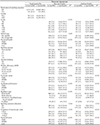Abstract
Background
This study used the data of Korea Youth Risk Behavior Web-based Survey (KYRBS) to confirm the relationship between electronic cigarette use for smoking cessation among Korean adolescents and demographic, health behavior, and school-life factors.
Methods
Data were taken from the 13th KYRBS in 2017. In this study on 62,276 adolescents, characteristics of 1,244 electronic cigarette users were compared with those of non-electronic cigarette users. The 1,244 adolescent electronic cigarette users were evaluated for characteristics related to smoking cessation. Among the related characteristics, demographic factors comprised sex, grade, economic status, weekly allowance, and residence type. Health status-related factors comprised physical activity, lifetime drinking experience, smoking amount, subjective health perception, and stress perception. School characteristics included school type, academic performance, and smoking cessation education. Chi-square test and logistic regression analysis were performed using complex sample analysis.
Results
The proportion of current electronic cigarette users was 2.2% (boys, 3.3%; girls, 0.9%). Of the 41.5% of cigarette users willing to quit smoking, 11% used electronic cigarettes for this purpose. Among the electronic cigarette users, characteristics related to smoking cessation were grade, weekly allowance, and residence type, but logistic regression analysis revealed that increases in grade (odds ratio [OR], 2.01; 95% confidence interval [CI], 1.21–3.35) and living with family (OR, 4.17; 95% CI, 1.89–9.18) were associated with smoking cessation.
Figures and Tables
References
2. Goniewicz ML, Zielinska-Danch W. Electronic cigarette use among teenagers and young adults in Poland. Pediatrics. 2012; 130(4):E879–E885.

3. Pearson JL, Richardson A, Niaura RS, Vallone DM, Abrams DB. e-Cigarette awareness, use, and harm perceptions in US adults. Am J Public Health. 2012; 102(9):1758–1766.

4. Cameron JM, Howell DN, White JR, Andrenyak DM, Layton ME, Roll JM. Variable and potentially fatal amounts of nicotine in e-cigarette nicotine solutions. Tob Control. 2014; 23(1):77–78.
5. Choi K, Forster J. Characteristics associated with awareness, perceptions, and use of electronic nicotine delivery systems among young US Midwestern adults. Am J Public Health. 2013; 103(3):556–561.

6. Grana R, Benowitz N, Glantz SA. Background Paper on E-cigarettes (Electronic Nicotine Delivery Systems). Geneva: World Health Organization Tobacco Free Initiative;2013.
7. World Health Organization (WHO). Electronic nicotine delivery systems. Geneva: WHO;2014.
8. Cho JH, Shin E, Moon SS. Electronic-cigarette smoking experience among adolescents. J Adolesc Health. 2011; 49(5):542–546.

9. Lee S, Grana RA, Glantz SA. Electronic cigarette use among Korean adolescents: a cross-sectional study of market penetration, dual use, and relationship to quit attempts and former smoking. J Adolesc Health. 2014; 54(6):684–690.

10. Korea Centers for Disease Control and Prevention. The Korea Youth Risk Behavior Web-based Survey. Sejong: Ministry of Health & Welfare of Korea;2016.
11. Oh JW, Lee EY, Lim JJ, Lee SH, Jin YS, Song BK, et al. Results from South Korea's 2018 Report Card on physical activity for children and youth. J Exerc Sci Fit. 2019; 17(1):26–33.

12. Chen M, Wang EK, Jeng YJ. Adequate sleep among adolescents is positively associated with health status and health-related behaviors. BMC Public Health. 2006; 6:59.

13. Yeh JS, Bullen C, Glantz SA. Clinical decisions: e-cigarettes and smoking cessation. N Engl J Med. 2016; 374:2172–2174.
14. Kim JY, Seo SW, Choi JE, Lee S. Awareness of electronic cigarettes among the general population and medical experts. JKSRNT. 2015; 6(2):102–117.

15. Yamin CK, Bitton A, Bates DW. E-cigarettes: a rapidly growing Internet phenomenon. Ann Intern Med. 2010; 153(9):607–609.

16. Hughes JR, Pillitteri JL, Callas PW, Callahan R, Kenny M. Misuse of and dependence on over-the-counter nicotine gum in a volunteer sample. Nicotine Tob Res. 2004; 6(1):79–84.

17. Hughes JR. Dependence potential and abuse liability of nicotine replacement therapies. Biomed Pharmacother. 1989; 43(1):11–17.

18. Wang X, Zhang X, Xu X, Gao Y. Electronic cigarette use and smoking cessation behavior among adolescents in China. Addict Behav. 2018; 82:129–134.

19. Park S, Lee H, Min S. Factors associated with electronic cigarette use among current cigarette-smoking adolescents in the Republic of Korea. Addict Behav. 2017; 69:22–26.

20. Malas M, van der Tempel J, Schwartz R, Minichiello A, Lightfoot C, Noormohamed A, et al. Electronic cigarettes for smoking cessation: a systematic review. Nicotine Tob Res. 2016; 18(10):1926–1936.

21. Yi YJ, Lee KJ, Kim YS. Influences of demographic, smoking, and smoking cessation factors on smoking cessation success in adolescent smokers. J Korea Contents Assoc. 2011; 11(4):303–311.

22. Woo SH, No GY, Park YS. Relationship between family function and hope in adolescents. J Korean Soc Sch Health. 2005; 18(1):47–58.
23. Emery EM, McDermott RJ, Holcomb DR, Marty PJ. The relationship youth substance use and area-specific self-esteem. J Sch Health. 1993; 63(5):224–228.




 PDF
PDF ePub
ePub Citation
Citation Print
Print





 XML Download
XML Download